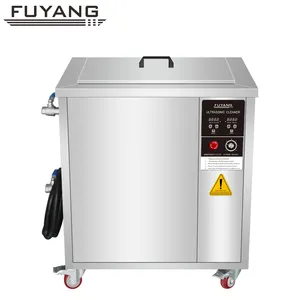
All categories
Featured selections
Trade Assurance
Buyer Central
Help Center
Get the app
Become a supplier

(1906 products available)




















































Sterilization plays a critical role in the medical field, ensuring that all instruments and surfaces are free of harmful microorganisms. This is where medical instrument cleaner come into play. These devices are essential in maintaining a sterile environment, particularly in medical settings such as hospitals, clinics, and laboratories. medical instrument cleaner are designed to eliminate bacteria, viruses, and other pathogens, thus preventing infections and ensuring patient safety. The technology behind medical instrument cleaner has evolved significantly, providing efficient and reliable sterilization processes that are crucial for the healthcare industry.
There are several types of medical instrument cleaner available, each designed for specific applications. The most common types include steam sterilizers, also known as autoclaves, which use high-pressure steam to sterilize equipment. These are ideal for heat-resistant items. On the other hand, ethylene oxide sterilizers are used for heat-sensitive instruments, utilizing a gas that permeates and sterilizes at lower temperatures. Another type is the dry heat sterilizer, which uses high temperatures to achieve sterilization, suitable for glassware and metal instruments. Additionally, there are plasma sterilizers that employ hydrogen peroxide plasma for low-temperature sterilization, making them suitable for delicate instruments. Each type of medical instrument cleaner offers unique advantages and is selected based on the specific needs of the medical facility.
medical instrument cleaner are equipped with a range of features that enhance their functionality and efficiency. Most equipment includes digital displays for easy monitoring of the sterilization cycle, ensuring precise control over temperature and time settings. Safety features such as automatic shut-off and pressure release valves are standard, protecting both the user and the equipment. Modern medical instrument cleaner often come with programmable settings, allowing customization for different loads and materials. Some advanced models feature data logging capabilities, enabling the tracking and documentation of sterilization processes for compliance and quality assurance. The ability to sterilize a wide range of materials, from surgical instruments to laboratory glassware, highlights the versatility of medical instrument cleaner.
The construction of medical instrument cleaner involves the use of high-quality materials to ensure durability and resistance to high temperatures and pressure. Stainless steel is commonly used for its corrosion resistance and strength, making it ideal for the chambers and trays of steam sterilizers. The seals and gaskets in medical instrument cleaner are typically made from heat-resistant silicone or rubber to maintain airtight conditions during the sterilization process. For ethylene oxide sterilizers, materials that resist chemical corrosion are essential. The choice of materials impacts the longevity and performance of medical instrument cleaner, ensuring they meet the rigorous demands of medical environments. Advanced materials and coatings are also being explored to enhance the efficiency and sustainability of these crucial devices.
Proper usage of medical instrument cleaner is crucial for achieving effective sterilization and ensuring the safety of medical instruments. It is important to follow manufacturer instructions and guidelines for loading and operating the equipment. Overloading can hinder the sterilization process, so materials should be arranged to allow steam or gas to circulate freely. Regular maintenance and calibration of medical instrument cleaner are necessary to ensure optimal performance, including routine checks of seals, valves, and temperature sensors. Training personnel on the correct use and maintenance of medical instrument cleaner can significantly enhance the reliability of the sterilization process. Additionally, documenting each sterilization cycle is essential for traceability and compliance with health regulations, providing assurance that all instruments are safe for use.
Selecting the right medical instrument cleaner for a medical facility requires careful consideration of several factors. First and foremost, the type of items to be sterilized should guide the choice. For instance, steam sterilizers are ideal for heat-resistant tools, while ethylene oxide sterilizers are better for delicate instruments. Understanding the compatibility of medical instrument cleaner with different materials ensures effective sterilization without damaging the items. Additionally, the size and capacity of the equipment should match the volume of instruments that need to be processed, ensuring efficiency in high-demand settings.
Another important consideration is the technological features of medical instrument cleaner. Modern devices often include advanced digital controls, programmable settings, and data logging capabilities. These features not only enhance user convenience but also improve the precision and reliability of the sterilization process. Facilities should evaluate whether these technological advancements align with their operational needs and budget constraints. Furthermore, energy efficiency and maintenance requirements of medical instrument cleaner should be assessed to ensure long-term cost-effectiveness and minimal downtime.
Regular maintenance of medical instrument cleaner is crucial for ensuring optimal performance and longevity. This includes routine cleaning of the chamber, checking and replacing seals and gaskets, and calibrating temperature and pressure sensors. Regular inspections by qualified technicians can help identify potential issues before they lead to equipment failure.
medical instrument cleaner ensures safety by effectively eliminating harmful microorganisms from medical instruments and surfaces. They are designed with safety features such as pressure release valves and automatic shut-off mechanisms to protect users from potential hazards during the sterilization process.
While medical instrument cleaner is versatile, not all types are suitable for every medical instrument. Heat-sensitive instruments require low-temperature sterilization methods like ethylene oxide or plasma sterilizers. It's essential to choose the appropriate equipment based on the material and design of the instruments to avoid damage.
Environmental considerations for medical instrument cleaner include energy consumption and waste management. Facilities can opt for energy-efficient models to reduce their carbon footprint. Proper disposal of consumables and adherence to environmental regulations are also important to minimize environmental impact.
Technological advancements have significantly improved medical instrument cleaner by enhancing efficiency, precision, and user-friendliness. Features like digital displays, programmable cycles, and data logging facilitate better control and documentation of the sterilization process, ensuring compliance with healthcare standards.